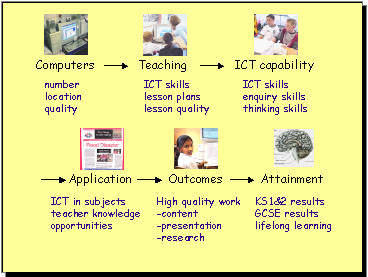|
The Vision for ICT
"Where there is no vision, the
people perish". - Proverbs
29:18
Underpinning the successful ICT work
that is seen in many schools today will usually be a vision that ICT is
not just a subject to be 'delivered', but that ICT offers an approach to
teaching and learning that can transform the school as a learning
institution.
The school's vision for
ICT will be something that sits well with the school's ethos, beliefs and
values. The school's vision for ICT will probably describe a point in time
when ICT systems, electronic curriculum materials, teaching and learning
methods and curriculum organisation will have reached a level of
development where significant gains in learning for all pupils will be
achieved.

A
vision for ICT should not be something so ideal as to be unattainable. A
vision for ICT should describe an achievable future for the school.
There is enough available evidence to confirm that ICT is a very special
phenomenon that has the power to improve learning and to change the way we
organise it. Members of this association have contributed their own
visions of how this might occur in the NAACE publication 'The Impact of ICT on Schooling'.
More
recently, a DfES-sponsored NAACE Think Tank on 'Transforming Learning'
produced a paper called 'Inspiring Change through ICT'. This document outlines
priorities and strategies which need to be put in place over the next few
years if the national vision of ICT as a force to transform learning is to
be achieved.
A vision for ICT in a school should seek to
complement national developments in this area.
It will also will
usefully reflect upon the following key points :
 How to
further develop the subject of ICT and the use of ICT in subjects How to
further develop the subject of ICT and the use of ICT in subjects
 How to improve the ways that pupils use ICT to promote
effective learning
How to improve the ways that pupils use ICT to promote
effective learning
 How to develop the way that teaching is organised so
as to maximise its effectiveness.
How to develop the way that teaching is organised so
as to maximise its effectiveness.
The vision is the starting
point on this journey. A vision should ideally be backed up with
beliefs which explain why traveling this journey is justified.
Those beliefs will take what we know about how ICT can improve teaching
and learning and relate this to the core purposes of the
school.
Taking a school along this journey can be
confusing unless the route is clear. An important feature of successful
development planning for ICT is to be clear about what should be in an ICT
policy, what should be in an ICT development plan, and what should be in
an ICT handbook. Placing things in their correct place will clarify the
way that a vision will be achieved.
A policy can be used to
communicate the vision to the school community, and to explain the beliefs
that underpin it. A policy explains what is intended to happen and the
process through which it will happen.
Policy - a
course of action, guiding principle, or procedure considered expedient,
prudent, or advantageous
A set of principles can
be identified in order to determine how decisions will be
made.
Principles are much more useful than rules in this respect. To
achieve the same task we may need hundreds of rules, but it could also be
achieved with very few principles.
Principle - a basic
or essential quality or element determining intrinsic nature or
characteristic behavior
A
development plan will sit alongside the policy. It will explain in
detail the parallel developments that will need to take place in order to
achieve the vision with the intended timeframe.
Procedures for how
the day to day organisation of the plan will function are best separated
from the policy. It is common for a school ICT policy to have the main
messages swamped by rules and procedural issues. Procedures, guidance,
rules and other operational matters should be placed in a handbook.
|
|


